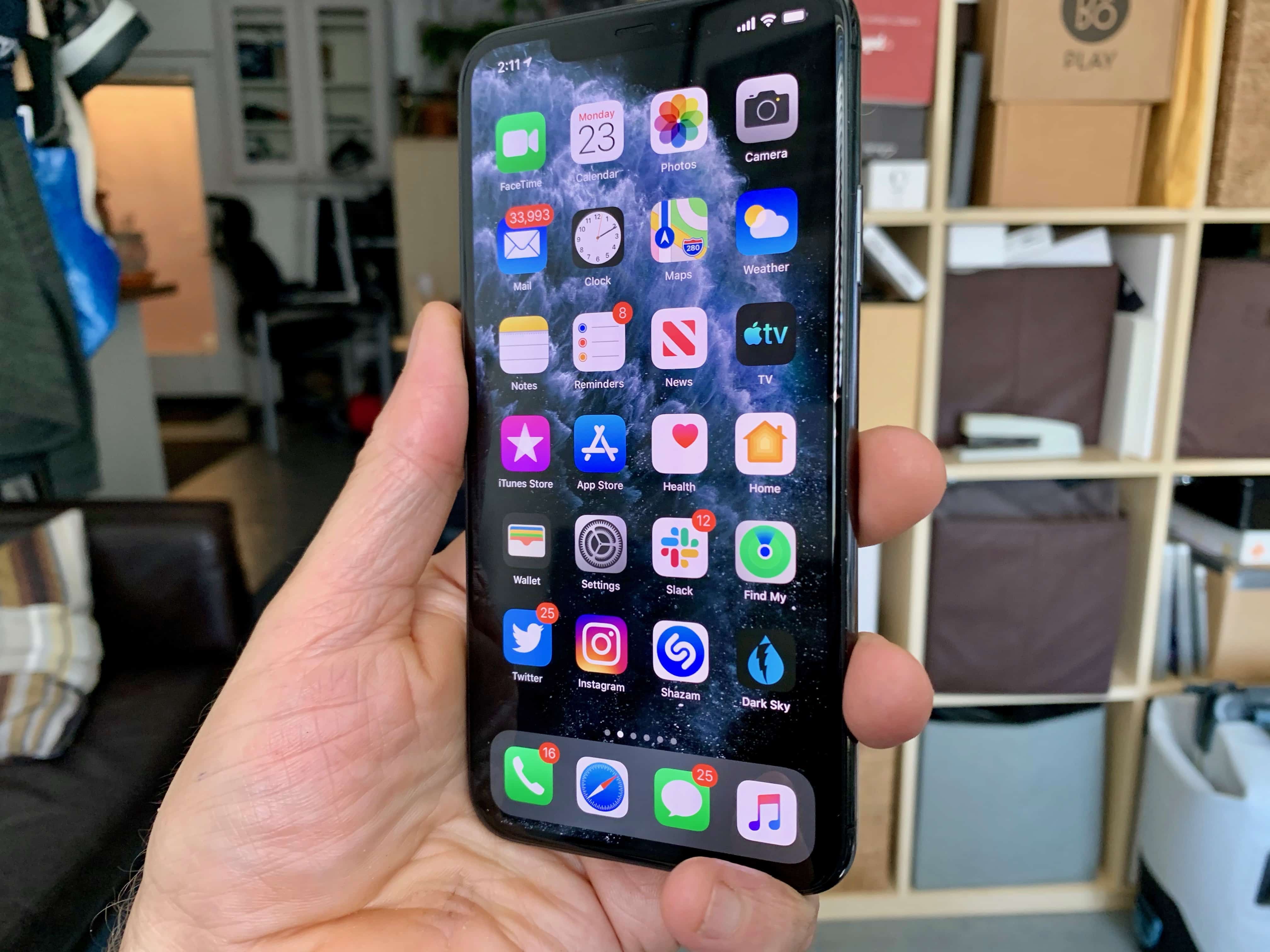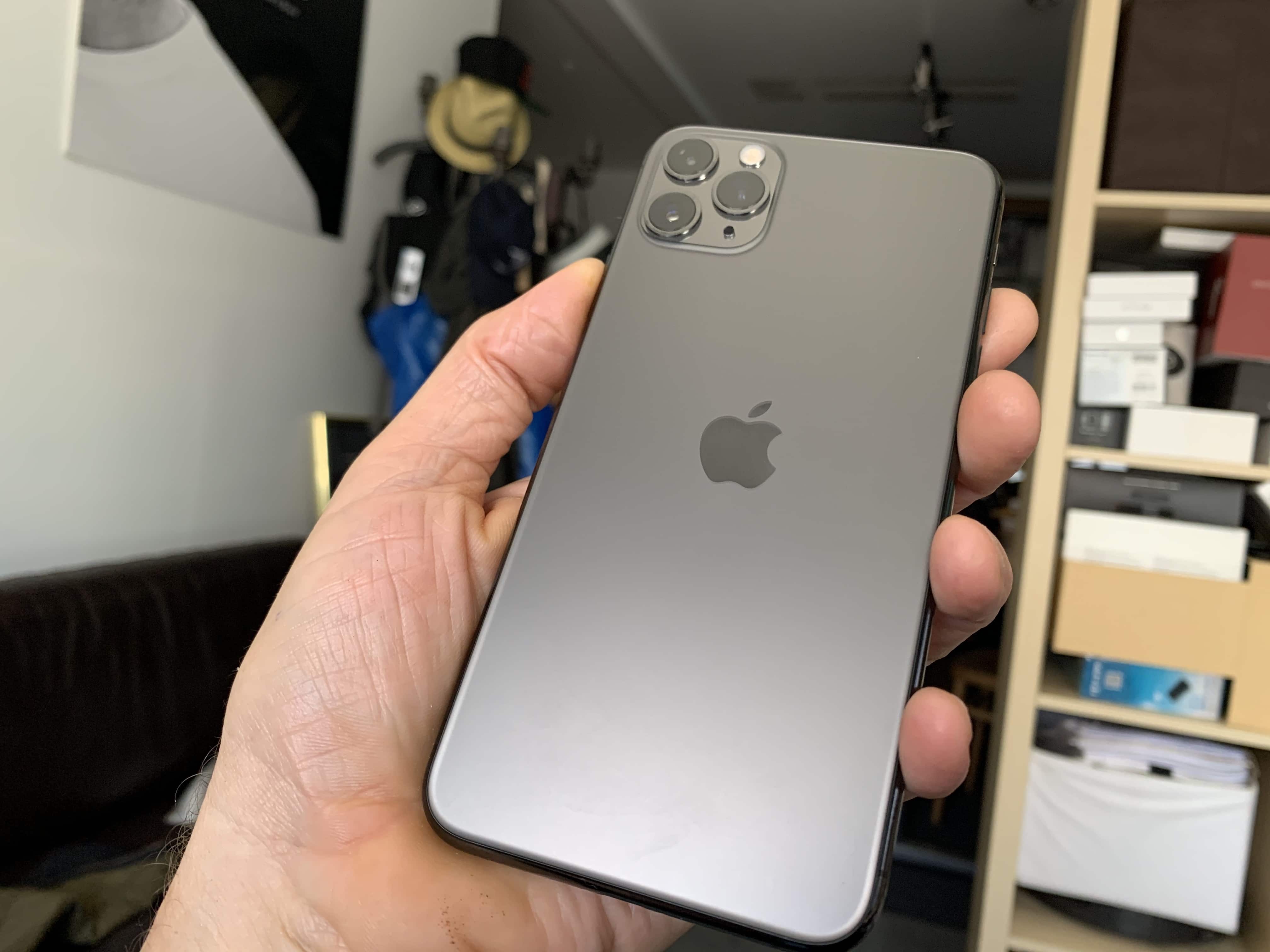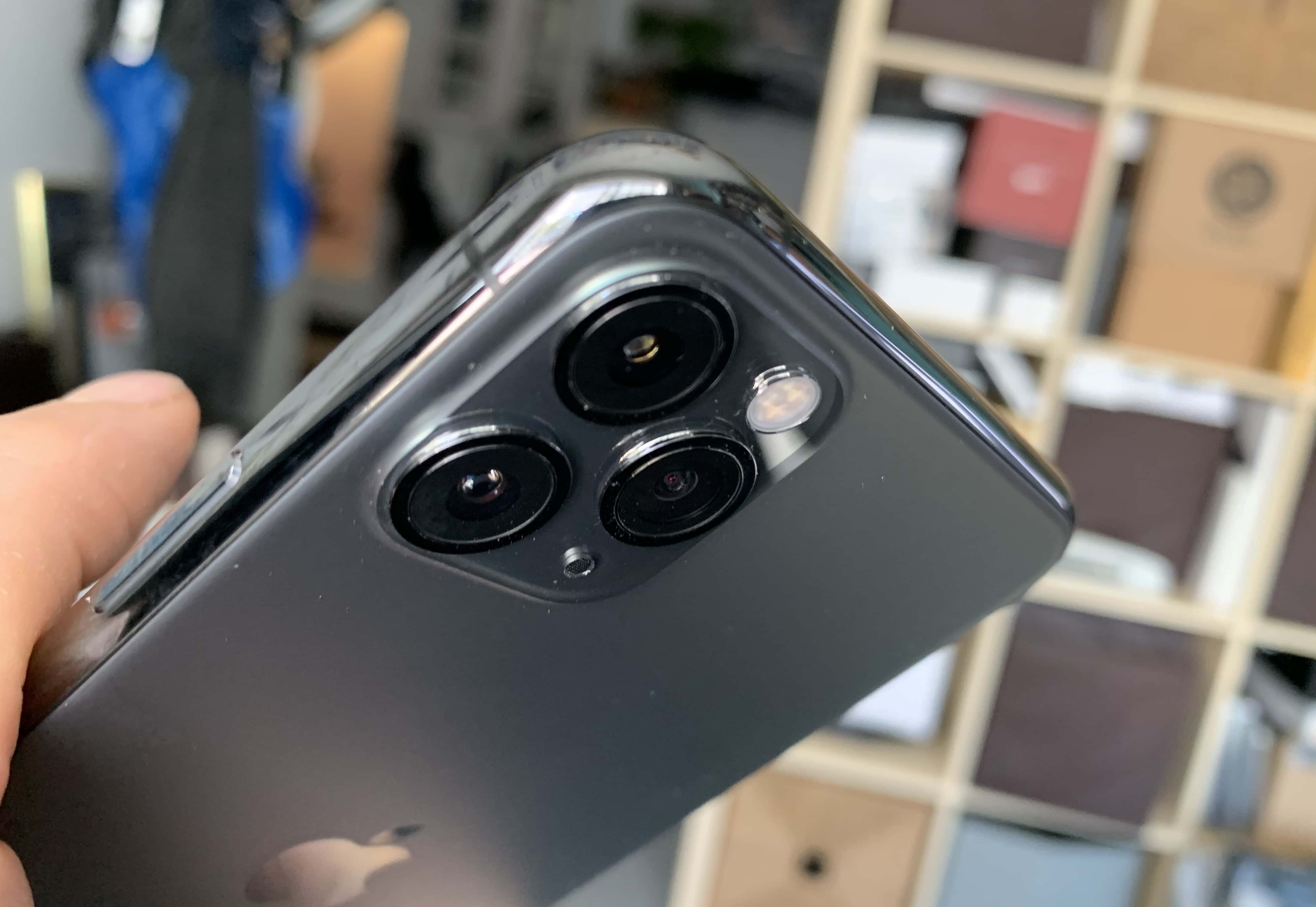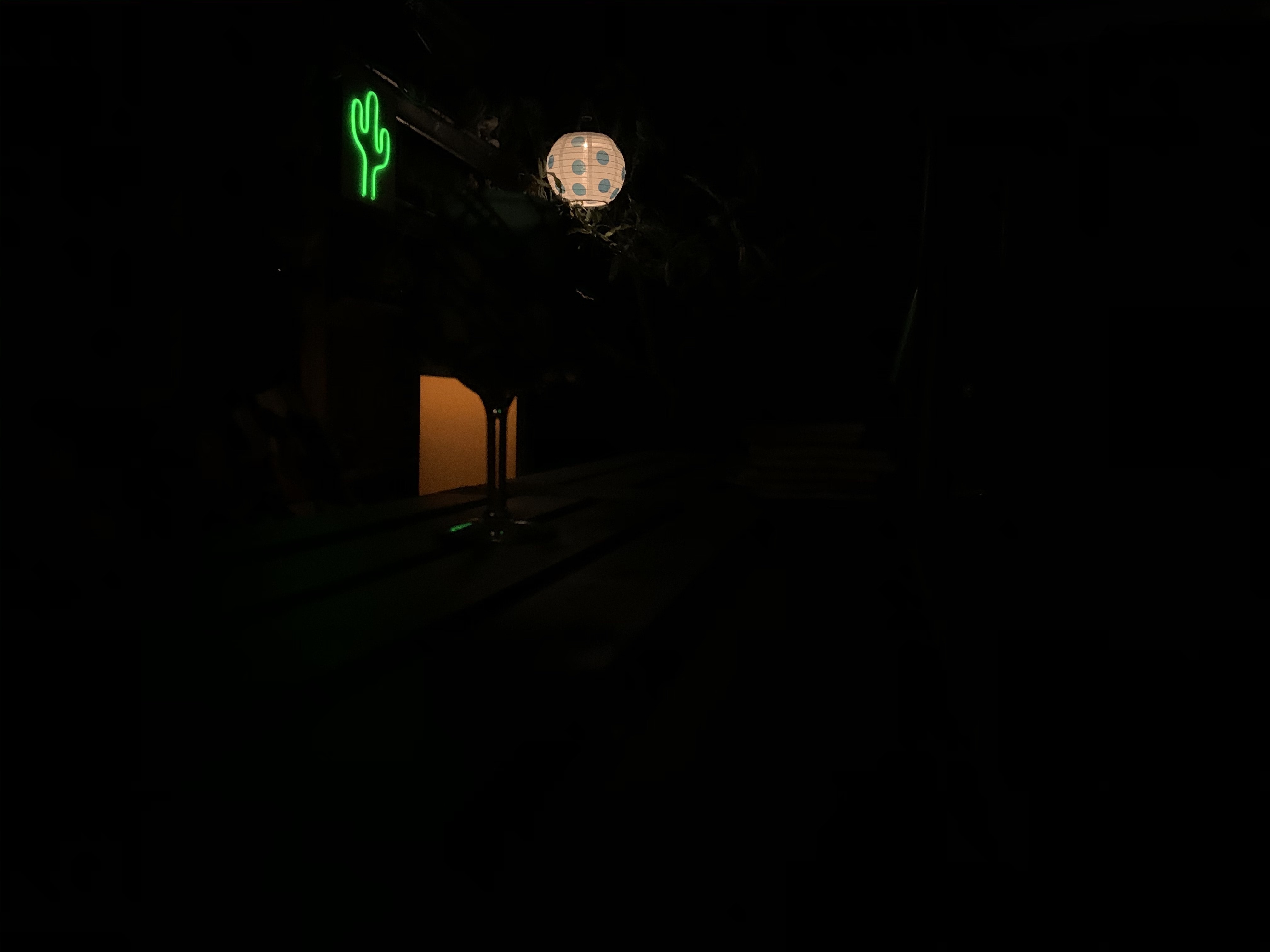This thing is a beauty. The first thing you notice is the glass back. The frosted matte finish makes it semi-translucent, giving it a weirdly illusory depth. It looks great. Not even the controversial, compound-eye camera bump can spoil its good looks. The iPhone 11 Pro Max is the best-looking iPhone to date, and I love it.
But don’t be fooled by the familiar design. This year’s refresh makes almost everything about Apple’s most expensive handset better than ever.
It’s faster, stronger and more water-resistant. It packs the best display you’ll find in a phone, and the best camera you’ve ever used. The battery lasts forever. Is it worth its hefty price tag? Absolutely.
Find out more in our full iPhone 11 Pro Max review.
iPhone 11 Pro Max review

Photo: Leander Kahney/Cult of Mac
Unlike the entry-level iPhone 11, which got a welcome price cut, the 11 Pro Max costs the same as its predecessor. You’ll pay $1,099 for the 64GB model, $1,249 for the 256GB model or $1,449 for the 512GB model.
Those prices didn’t seem to hold back iPhone XS Max last year; it didn’t sell as well as iPhone XR, but it proved incredibly popular. And now you get a whole lot more for your money.
Brilliant design made even better

Photo: Leander Kahney/Cult of Mac
iPhone’s design changed only slightly this year, and we’re OK with that. The few changes Apple made are mostly nice improvements to what we considered an already excellent design.
The 11 Pro Max is more water-resistant than its predecessors, and it’s tougher, thanks to what Apple says is the strongest glass ever used in a smartphone. Its rear panel also has a matte finish now, which looks fantastic, especially in space gray. It may be my favorite case material so far.
That finish doesn’t add substantial grip, unfortunately, so you probably still will want a case. If only I had the guts to go case-less! But it’s glass! I daren’t risk it! But it looks terrific, and it’s not a fingerprint magnet like the shiny glass we got before.
The Apple logo on the back of this year’s iPhone lineup is now perfectly centered, and the iPhone branding has disappeared. In fact, you won’t find any writing anywhere on the 11 Pro Max.
About that camera bump …
You will find a rather gigantic camera hump, however. It has ballooned to accommodate a third rear-facing lens, and you can’t miss it. The compound-eye aesthetic gives some the heebie-jeebies, but I actually like it. It looks utilitarian. It signals that the iPhone is a serious piece of picture-taking hardware.
Even if you don’t like it, you’ll soon get used to the hump, though. And it’s a small price to pay for the camera improvements that third lens brings (more on that later). It’s also not the only thing that got bigger.
The 11 Pro Max is taller, wider and thicker than the XS Max. And it’s heavier at 7.97 ounces — up from 7.34 ounces. These don’t seem like hefty increases on paper, but they are noticeable.
Apple also moved the iPhone’s mute switch and physical buttons. They’ve all shifted slightly downward, so they’re now a little easier to reach. The non-opposing buttons also make it slightly harder to take accidental screenshots.
None of these are particularly significant alterations. But they do mean that your XS Max cases won’t fit 11 Pro Max.
An XDR display in your pocket
iPhone 11 Pro Max packs the first XDR display Apple ever put into a phone. It’s the Super Retina XDR display, to be precise, and it is absolutely outstanding.
You get the same OLED technology found in the XS Max, but it’s even better now. It boasts a staggering 2,000,000:1 contrast ratio (up from 1,000,000:1 in the XS Max), and reaches a maximum typical brightness of 800 nits (up from 625 nits).
The Super Retina XDR display gets even brighter — up to 1,200 nits — when you’re viewing HDR photos or watching 4K HDR movies. And yet, it is up to 15% more efficient than last year’s Super Retina screen, so it is kinder to your battery.
Other features, like True Tone, support for the P3 wide color gamut and HDR10, and tap-to-wake make a return this year. But 3D Touch is gone in favor of what Apple calls Haptic Touch.
Haptic Touch works in exactly the same way, and gives you the same functionality you’re used to. It’s just not pressure-sensitive. So, instead of using a firm press, you simply tap and hold. It’s a bit fiddly when you want to move or delete apps on the Home screen — you sometimes bring up Haptic Touch menus instead — but if you just keep holding, the icons begin jiggling.
The best camera you ever used

Photo: Leander Kahney/Cult of Mac
iPhone 11 Pro’s new triple camera system is the biggest reason to upgrade this year. It gets you Wide, Ultra Wide and Telephoto lenses — all with 12-megapixel sensors — that enable the best photos and videos you’ve ever gotten on a phone.
The new Ultra Wide lens is terrific. It lets you capture four times more in a single frame, and it makes for stunning landscape photos. It’s also handy for taking pictures in tight spaces when you don’t have room to create distance between you and your subject. The addition of a wide-angle lens is genius. It’s a great addition for everyday photo taking. And, for me, it’s much more useful than a telephoto lens, which I don’t use much. By contrast, almost every picture I’ve taken with the 11 Pro has been with the Ultra Wide lens.
The other lenses have improved, too, and the True Tone flash is brighter. Apple also threw in a new image signal processor that allows for next-generation Smart HDR and a Night mode.
Apple didn’t ignore iPhone 11’s front-facing camera, either. It packs a 12-megapixel sensor (up from 7 megapixels), which means you can enjoy 4K video recording and slow-motion at 24 frames per second.
Night Mode looks fantastic

Photo: Leander Kahney/Cult of Mac

Photo: Leander Kahney/Cult of Mac
Night Mode will knock your socks off. It dramatically improves your photos in low light and produces results that simply weren’t possible on previous (Apple) handsets. And unlike competing devices, iPhone keeps colors as natural as possible.
Night Mode enables automatically in low-light conditions, and the first time it kicks in is like having amazing night vision. You can see clearly in almost pitch black; it lights up the dark even when you can’t see with your own eyes. It’s literally laugh-out-loud amazing when you see it for the first time. But unlike night-vision goggles, the scene displays in full color instead of monochromatic green.
The resulting Night Mode pictures aren’t always naturalistic, but to my eye, they look better than images produced by Google’s rival Night Sight system. While also impressive, Google’s pictures look too unnatural to me. I prefer Apple’s aesthetic. Night Mode photos look like photos taken at night.
Either way, Night Mode is much, much better than using flash.
Unparalleled performance in your palms
Just like its siblings, the iPhone 11 Pro Max is powered by the new A13 Bionic chip. It’s the fastest chip ever in a smartphone, Apple says, with up to 20% faster processing and graphics than last year’s A12. It can process a staggering 1 trillion operations a second.
Apple’s A13 chip
The A13 makes for a wonderfully smooth and snappy experience no matter what you’re doing, but it doesn’t really feel any faster than its predecessor just yet. Stick an 11 Pro Max and a XS Max side-by-side and you’ll see identical performance from both.
That will change when developers take full advantage of the A13’s extra power, of course. And there are other things the A13 brings that you can enjoy in the meantime.
Apple’s newest chip uses up to 40% less power than the A12, offers up to 38% faster Wi-Fi 6, and packs an additional 1GB of RAM (for a total of 4GB). This makes things like multitasking and switching between multiple tabs in Safari a more seamless experience.
Apple’s U1 chip
There’s also a brand new U1 chip, which uses a special ultra wideband radio that enables 11 Pro Max to precisely pinpoint its own location relative to other U1 devices. What does that mean?
Well, when sharing a file over AirDrop in iOS 13.1, for instance, the U1 lets you point your device at another iPhone 11 user to prioritize them as the recipient. And that’s just the beginning.
When the U1 chip makes its way into other devices — such as the rumored “Apple Tag” trackers — it will make it easier then ever to locate lost items. You won’t just see when those items are nearby; iPhone 11 will be able to lead you right to them.
The fastest Face ID
The A13 chip, coupled with improved front-facing sensors, also makes Face ID up to 30% faster, Apple says. In most cases, your iPhone will unlock before you’ve even had time to notice it’s happening.
Face ID works from further away, and from more angles now, too. So, you don’t have to hold your iPhone directly in front of your face anymore. You can unlock it while it’s laying on your desk.
TBH, you probably won’t notice a huge difference in either the speed or the angle in everyday use, but suffice to say, it’s fast and seamless.
iPhone 11 Pro Max: The best battery life yet
More efficient components and a larger battery mean the 11 Pro Max delivers the best battery life you’ve ever gotten from an iPhone. It lasts up to five hours longer than the XS Max between charges. Battery life was already great on the previous iPhone, but now it’s bonkers.
Apple says this is “the most dramatic leap in battery life ever,” and it sure is noticeable. The chances of you draining the 11 Pro Max before the day is done are slim. The phone easily lasts a full day and more, depending on usage. My phone is currently at 20% and hasn’t been charged since yesterday morning. That’s almost 36 hours with plenty of charge to go.
When you do need to top-up, iPhone 11’s fast-charging capabilities will get you a 50% charge in just 30 minutes. And Apple finally started shipping 18-watt fast-charging adapters as standard with 11 Pro and 11 Pro Max.
iPhone 11 Pro Max review: The verdict
The iPhone 11 Pro Max is the perfect illustration of Apple’s time-tested strategy of incrementally improving its devices year after year. No, it’s not a radical new design. And, aside from the cameras, Apple simply updated most components rather than radically overhauling them. But the result is a great, great phone. The iPhone 11 Pro Max brings phenomenal cameras, drool-worthy industrial design, exceptional battery life, a gorgeous screen and speedy chips that will keep the phone relevant and useable for many years to come.
Yeah, it’s pricey. Plunking down more than $1,200 for a new phone always hurts. And yeah, the cheaper iPhone 11, which offers many of the same features, is a better deal for $300 less. But the better screen and the better cameras of the Pro Max make the premium well worth it.
Plunk down your cash and rejoice — the iPhone 11 Max Pro is phenomenal!
Killian Bell contributed to this review.
![IPhone 11 Pro Max: The best gets even better [Review] How gorgeous is the iPhone 11 Max Pro?](https://www.cultofmac.com/wp-content/uploads/2019/09/534A3822-1.jpg)

